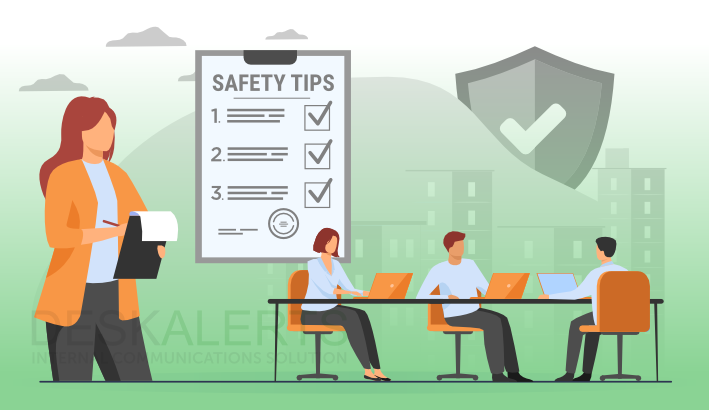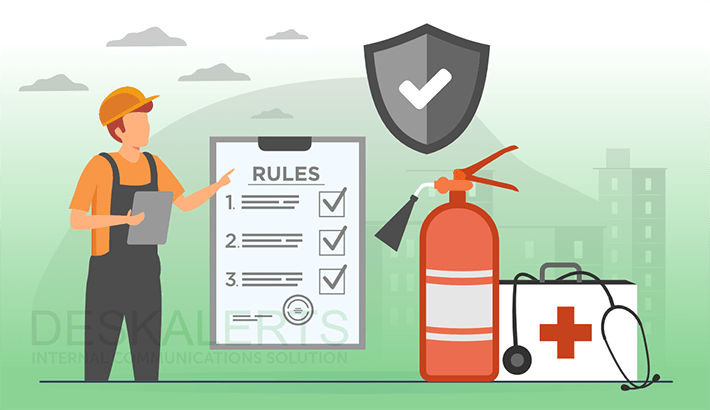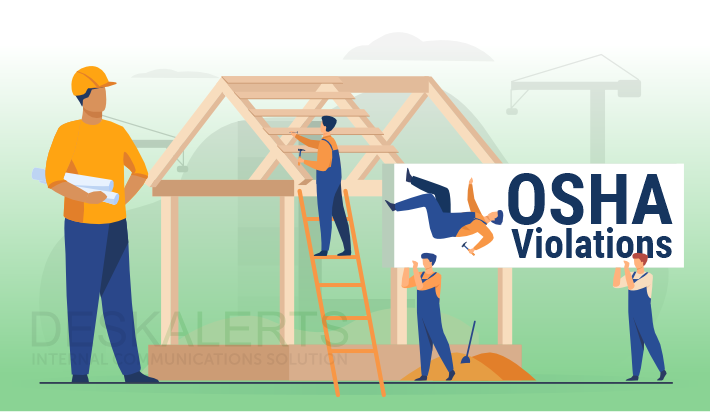
Employee safety programs are not just a regulatory requirement; they are a strategic imperative for modern businesses. By prioritizing safety, companies protect their most valuable asset—their employees—while simultaneously safeguarding their reputation, reducing costs, and enhancing operational efficiency.
Investing in comprehensive safety programs is not only a moral obligation but also a wise business decision that yields long-term benefits for the organization and its stakeholders.
Table of Contents
1. Why employee safety programs are beneficial to business
2. What are safety incentive programs?
3. 10 safety incentive program examples to try in your organization
4. How DeskAlerts can help you communicate your employee safety incentive programs
Why employee safety programs are beneficial to business
There are several compelling reasons why your company needs to invest in comprehensive employee safety programs:
- Protecting your people
Employees are the most valuable asset of any organization. Ensuring their safety and well-being not only demonstrates ethical responsibility but also protects the human capital upon which your business relies. Safety programs mitigate the risk of workplace accidents, injuries, and illnesses, thereby preserving your workforce and maintaining productivity levels.
- Legal compliance and risk management
Compliance with occupational health and safety regulations is not negotiable. Failure to adhere to these standards can result in severe legal consequences, including fines, penalties, and lawsuits. By implementing effective safety programs, you demonstrate your commitment to compliance, reducing the likelihood of regulatory violations and associated liabilities.
- Offering a post to employee morale and engagement
When employees feel safe and supported in their work environment, their morale and engagement levels soar. Safety programs convey that the company values its employees' well-being, fostering a culture of trust, loyalty, and commitment. Employees who feel secure are more likely to be motivated, productive, and invested in the success of the organization.
- Lowered costs and enhanced efficiency
Workplace accidents and injuries incur significant financial costs for businesses, including medical expenses, workers' compensation claims, and lost productivity.
By proactively addressing safety risks through training, hazard identification, and preventive measures, companies can minimize these costs, optimize operational efficiency, and protect their bottom line.
- Reputation and brand image
A workplace safety incident can tarnish a company's reputation and brand image, both internally and externally. Negative publicity stemming from accidents or safety lapses can erode stakeholder trust, damage customer confidence, and deter top talent from joining the organization.
- Reducing the risk of operational disruptions
Workplace accidents not only cause immediate harm but can also disrupt business operations, leading to downtime, delays, and missed deadlines. Safety programs help identify potential hazards, implement preventive measures, and establish emergency protocols, minimizing the risk of disruptions and ensuring continuity of operations.
- Attracting and retaining top talent
In today's competitive labor market, job seekers prioritize employers who prioritize their well-being and safety. Companies with robust safety programs have a competitive advantage in attracting top talent who seek a secure and supportive work environment. Investing in employee safety enhances retention rates by fostering loyalty and job satisfaction among existing staff.
What are safety incentive programs?
Safety incentive programs are structured initiatives implemented by organizations to encourage and reward employees for maintaining safe work practices and adhering to safety protocols.
These programs often offer incentives such as bonuses, recognition, or prizes to individuals or teams that demonstrate exemplary commitment to workplace safety.
By promoting a culture of safety awareness and accountability, a safety incentive program aims to reduce accidents, injuries, and near misses, ultimately fostering a safer and healthier work environment for all employees
30 Safety Topics and Messages to Send
10 safety incentive program examples to try in your organization
If you’re looking at new and innovative ways to boost safety in your company, a safety incentive program can be a great addition to your workplace safety efforts. If you’re not sure where to start, here are 10 safety incentive program examples to consider:
- Recognition awards
Acknowledge and celebrate employees who consistently demonstrate adherence to safety protocols and contribute to a safe work environment through certificates, plaques, or public recognition.
- Safety achievement bonuses
A safety incentive program can provide monetary rewards or bonuses to individuals or teams that achieve specific safety milestones, such as a certain number of accident-free days or completing safety training modules.
- Safety scorecards
Implement a scoring system that tracks and rewards departments or teams based on their safety performance metrics, such as the number of reported hazards addressed or safety audits completed.
- Safety contests
Organize friendly competitions or challenges related to safety goals, such as identifying potential hazards or suggesting safety improvement initiatives, with prizes for winners.
- Safety gear reimbursement
Offer reimbursement or subsidies for employees who invest in personal protective equipment (PPE) or safety gear beyond what is provided by the company, encouraging them to prioritize their safety.
- Peer-to-peer recognition
Encourage employees to recognize their colleagues for practicing safe behaviors or taking proactive steps to prevent accidents through a peer-to-peer recognition program, fostering a culture of mutual accountability.
- Safety training incentives
Provide incentives such as paid time off or gift cards for employees who actively participate in safety training sessions, workshops, or certification programs to enhance their knowledge and skills.
- Safety suggestion programs
Establish a platform for employees to submit safety improvement suggestions or innovative ideas for hazard mitigation, with rewards for implemented suggestions or the most impactful safety recognition ideas.
- Departmental safety competitions
Organize inter-departmental safety competitions or challenges focused on specific safety objectives, with rewards for the department that demonstrates the most improvement or innovation in safety practices.
- Safety culture surveys
Conduct periodic surveys to assess the organization's safety culture and employee perceptions of safety practices, offering rewards or incentives to employees who participate and provide constructive feedback to drive continuous improvement efforts.
These employee safety incentive programs aim to motivate and engage employees in prioritizing safety, fostering a culture of shared responsibility and continuous improvement in workplace safety practices.
How DeskAlerts can help you communicate your employee safety incentive programs
Effective communication is crucial for employee safety incentive programs as it ensures clarity of program goals, promotes understanding of safety protocols, encourages participation, and fosters a culture of transparency and accountability.
Clear and timely communication helps in driving engagement and reinforcing the importance of safety in the workplace and the aims of a safety incentive program.
DeskAlerts is a powerful communication tool that can be leveraged to promote and enhance your employee safety incentive programs effectively by cutting through other “noise’ in the workplace to ensure your information reaches staff. Ways DeskAlerts can help include:
- Targeted notifications: Send targeted alerts directly to employees' computers or mobile devices to announce the launch of a safety incentive program, remind them of upcoming deadlines, or communicate important safety messages.
- Visual alerts: Utilize attention-grabbing visual alerts, such as pop-up notifications or desktop tickers, to ensure employees see and engage with safety-related content promptly.
- Multimedia content: Enhance communication by including multimedia elements such as videos, infographics, or interactive quizzes within DeskAlerts notifications to educate employees about safety protocols and incentivize participation in the program.
- Real-time updates: Keep employees informed about safety performance metrics, milestones achieved in safety incentive programs, or upcoming safety events in real-time through DeskAlerts, fostering transparency and accountability.
- Feedback collection: Use DeskAlerts to collect feedback from employees regarding their experiences with a safety incentive program, suggestions for improvement, or future safety program ideas.
- Recognition and rewards: A safety recognition program can celebrate the achievements of employees who demonstrate exemplary commitment to safety by showcasing their accomplishments through DeskAlerts notifications, reinforcing a culture of recognition and appreciation.
***
By leveraging DeskAlerts as a communication tool, organizations can effectively promote their employee safety incentive programs, engage employees, and reinforce a culture of safety throughout the workplace.
FAQ
What is a safety incentive program?
Safety incentive programs are structured initiatives implemented by organizations to encourage and reward employees for maintaining safe work practices and adhering to safety protocols, often through incentives like bonuses or recognition.
Is a safety incentive program a good idea?
Safety incentive programs are a beneficial strategy for fostering a culture of safety in the workplace. By incentivizing safe behaviors and practices, organizations can reduce accidents, injuries, and associated costs while promoting employee engagement, morale, and well-being.
Does OSHA allow safety incentives?
OSHA (Occupational Safety and Health Administration) allows safety incentive programs as long as they do not discourage employees from reporting workplace injuries or illnesses. Incentives should focus on promoting safe behaviors and practices rather than penalizing employees for reporting incidents.
What are the 4 examples of incentives?
Four safety incentive program examples include recognition awards for safe practices, bonuses for achieving safety milestones, safety gear reimbursement programs, and peer-to-peer recognition for promoting safety culture. These incentives aim to motivate employees to prioritize safety and contribute to a safer work environment.
 Caroline Duncan
Caroline Duncan







